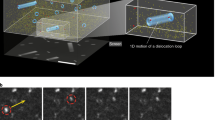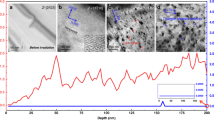Abstract
ELECTRICAL resistivity measurements have been made by many workers on quenched, irradiated or plastically deformed metals, in order to study the production of defects by these various treatments. By observing the recovery of the resistivity on annealing, it is possible to study the mobility of the various defects out of the material or to internal sinks. In this communication we present some results on the mobility of defects, introduced by low-temperature plastic deformation in titanium and zirconium.
This is a preview of subscription content, access via your institution
Access options
Subscribe to this journal
Receive 51 print issues and online access
$199.00 per year
only $3.90 per issue
Buy this article
- Purchase on Springer Link
- Instant access to full article PDF
Prices may be subject to local taxes which are calculated during checkout
Similar content being viewed by others
References
Zartman, I. F., Nuclear Eng. and Sci. Congr. (Cleveland), Preprint No. 89 (1955).
Seeger, A., Second Geneva Conf. Peaceful Uses of Atomic Energy, 998 (1958).
Koehler, J. S., Henderson, J. W., and Bredt, J. H., “Creep and Recovery”, 1 (American Society for Metals, 1957).
Cottrell, A. H., symposium on Vacancies and Other Point Defects in Metals and Alloys, Institute of Metals, London, 1 (1958).
Sosin, A., and Koehler, J. S., Phys. Rev., 101, 972 (1956).
Author information
Authors and Affiliations
Rights and permissions
About this article
Cite this article
SMITH, E., STAGG, M. Production and Mobility of Point Defects in Titanium and Zirconium. Nature 189, 300–301 (1961). https://doi.org/10.1038/189300a0
Issue Date:
DOI: https://doi.org/10.1038/189300a0
Comments
By submitting a comment you agree to abide by our Terms and Community Guidelines. If you find something abusive or that does not comply with our terms or guidelines please flag it as inappropriate.



